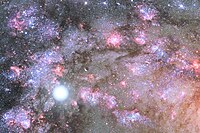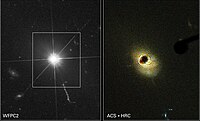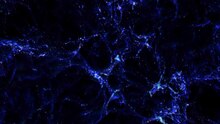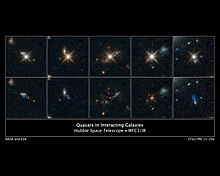From Wikipedia, the free encyclopedia
Artist's rendering of the accretion disk in
ULAS J1120+0641, a very distant quasar powered by a black hole with a mass two billion times that of the Sun.
[1] Credit:
ESO/M. Kornmesser
A
quasar (
) (also
quasi-stellar object or
QSO) is an
active galactic nucleus of very high
luminosity. A quasar consists of a
supermassive black hole surrounded by an orbiting
accretion disk of gas. As gas in the accretion disk falls toward the black hole,
energy is released in the form of
electromagnetic radiation. Quasars emit energy across the
electromagnetic spectrum and can be observed at
radio,
infrared,
visible,
ultraviolet, and
X-ray wavelengths. The most powerful quasars have luminosities exceeding 10
41 W, thousands of times greater than the luminosity of a large
galaxy such as the
Milky Way.
[2]
The term "quasar" originated as a
contraction
of "quasi-stellar radio source", because quasars were first identified
as sources of radio-wave emission, and in photographic images at visible
wavelengths they resembled point-like stars. High-resolution images of
quasars, particularly from the
Hubble Space Telescope, have demonstrated that quasars occur in the centers of galaxies, and that some quasar host galaxies are strongly
interacting or
merging galaxies.
[3]
Quasars are found over a very broad range of
distances (corresponding to
redshifts
ranging from z < 0.1 for the nearest quasars to z > 7 for the
most distant known quasars), and quasar discovery surveys have
demonstrated that quasar activity was more common in the distant past.
The peak epoch of quasar activity in the
Universe corresponds to redshifts around 2, or approximately 10 billion years ago.
[4] As of 2011, the
most distant known quasar is at redshift z=7.085; light observed from this quasar was emitted when the Universe was only 770 million years old.
[5]
Overview
Because quasars are distant objects, any light which reaches the
Earth is redshifted due to the
metric expansion of space.
[6]
Quasars inhabit the very center of active, young galaxies, and are
among the most luminous, powerful, and energetic objects known in the
universe, emitting up to a thousand times the energy output of the
Milky Way,
which contains 200–400 billion stars. This radiation is emitted across
the electromagnetic spectrum, almost uniformly, from X-rays to the
far-infrared with a peak in the ultraviolet-optical bands, with some
quasars also being strong sources of radio emission and of gamma-rays.
Hubble images of quasar
3C 273. At right, a
coronagraph is used to block the quasar's light, making it easier to detect the surrounding host galaxy.
Quasar
QSO-160913+653228
is so distant its light has taken nine billion years to reach the
telescope that took this photo, two thirds of the time that has elapsed
since the
Big Bang.
[7]
In early optical images, quasars appeared as
point sources, indistinguishable from stars, except for their peculiar spectra. With infrared telescopes and the
Hubble Space Telescope, the "host galaxies" surrounding the quasars have been detected in some cases.
[8]
These galaxies are normally too dim to be seen against the glare of the
quasar, except with special techniques. Most quasars, with the
exception of
3C 273 whose average
apparent magnitude is 12.9, cannot be seen with small telescopes.
The
luminosity
of some quasars changes rapidly in the optical range and even more
rapidly in the X-ray range. Because these changes occur very rapidly
they define an upper limit on the volume of a quasar; quasars are not
much larger than the
Solar System.
[9] This implies an extremely high
power density.
[10] The mechanism of brightness changes probably involves
relativistic beaming of
astrophysical jets pointed nearly directly toward Earth. The highest
redshift quasar known (as of June 2011) is
ULAS J1120+0641, with a redshift of 7.085, which corresponds to a
comoving distance of approximately 29 billion
light-years from Earth (see more discussion of how cosmological distances can be greater than the light-travel time at
metric expansion of space).
Quasars are believed to be powered by
accretion of material into
supermassive black holes in the nuclei of distant galaxies, making these luminous versions of the general class of objects known as
active galaxies. Since light cannot escape the black holes, the escaping energy is actually generated outside the
event horizon by gravitational stresses and immense
friction on the incoming material.
[11] Central masses of 10
5 to 10
9 solar masses have been measured in quasars by using
reverberation mapping.
Several dozen nearby large galaxies, with no sign of a quasar nucleus,
have been shown to contain a similar central black hole in their nuclei,
so it is thought that all large galaxies have one, but only a small
fraction are active (with enough accretion to power radiation), and it
is the activity of these black holes that are seen as quasars. The
matter accreting onto the black hole is unlikely to fall directly in,
but will have some angular momentum around the black hole that will
cause the matter to collect into an
accretion disc.
Quasars may also be ignited or re-ignited when normal galaxies merge
and the black hole is infused with a fresh source of matter. In fact, it
has been suggested that a quasar could form as the
Andromeda Galaxy collides with our own
Milky Way galaxy in approximately 3–5 billion years.
[11][12][13]
Properties
The
Chandra
X-ray image is of the quasar PKS 1127-145, a highly luminous source of
X-rays and visible light about 10 billion light years from Earth. An
enormous X-ray jet extends at least a million light years from the
quasar. Image is 60 arcsec on a side.
RA 11h 30m 7.10s
Dec -14° 49' 27" in Crater. Observation date: May 28, 2000. Instrument: ACIS.
More than 200,000 quasars are known, most from the
Sloan Digital Sky Survey. All observed quasar spectra have
redshifts between 0.056 and 7.085. Applying
Hubble's law to these redshifts, it can be shown that they are between 600 million
[14] and 28.85 billion
light-years away (in terms of
comoving distance).
Because of the great distances to the farthest quasars and the finite
velocity of light, they and their surrounding space appear as they
existed in the very early universe.
The power of quasars originates from supermassive black holes that
are believed to exist at the core of all galaxies. The Doppler shifts of
stars near the cores of galaxies indicate that they are rotating around
tremendous masses with very steep gravity gradients, suggesting black
holes.
Although quasars appear faint when viewed from Earth, they are
visible from extreme distances, being the most luminous objects in the
known universe. The brightest quasar in the sky is
3C 273 in the
constellation of
Virgo. It has an average
apparent magnitude of 12.8 (bright enough to be seen through a medium-size amateur
telescope), but it has an
absolute magnitude of −26.7.
[15] From a distance of about 33
light-years, this object would shine in the sky about as brightly as our
sun. This quasar's
luminosity is, therefore, about 4 trillion (4 × 10
12) times that of the Sun, or about 100 times that of the total light of giant galaxies like the
Milky Way.
[15] This assumes the quasar is radiating energy in all directions, but the
active galactic nucleus
is believed to be radiating preferentially in the direction of its jet.
In a universe containing hundreds of billions of galaxies, most of
which had active nuclei billions of years ago but only seen today, it is
statistically certain that thousands of energy jets should be pointed
toward the Earth, some more directly than others. In many cases it is
likely that the brighter the quasar, the more directly its jet is aimed
at the Earth.
The hyperluminous quasar
APM 08279+5255 was, when discovered in 1998, given an
absolute magnitude of −32.2. High resolution imaging with the
Hubble Space Telescope and the 10 m
Keck Telescope revealed that this system is
gravitationally lensed.
A study of the gravitational lensing of this system suggests that the
light emitted has been magnified by a factor of ~10. It is still
substantially more luminous than nearby quasars such as 3C 273.
Quasars were much more common in the early universe than they are today. This discovery by
Maarten Schmidt in 1967 was early strong evidence against the
Steady State cosmology of
Fred Hoyle, and in favor of the
Big Bang cosmology. Quasars show the locations where massive black holes are growing rapidly (via
accretion).
These black holes grow in step with the mass of stars in their host
galaxy in a way not understood at present. One idea is that jets,
radiation and winds created by the quasars, shut down the formation of
new stars in the host galaxy, a process called 'feedback'. The jets that
produce strong radio emission in some quasars at the centers of
clusters of galaxies are known to have enough power to prevent the hot gas in those clusters from cooling and falling onto the central galaxy.
Quasars' luminosities are variable, with time scales that range from
months to hours. This means that quasars generate and emit their energy
from a very small region, since each part of the quasar would have to be
in contact with other parts on such a time scale as to allow the
coordination of the luminosity variations. This would mean that a quasar
varying on a time scale of a few weeks cannot be larger than a few
light-weeks across. The emission of large amounts of power from a small
region requires a power source far more efficient than the nuclear
fusion that powers stars. The release of
gravitational energy[16]
by matter falling towards a massive black hole is the only process
known that can produce such high power continuously. Stellar explosions –
supernovas and
gamma-ray bursts
– can do likewise, but only for a few weeks. Black holes were
considered too exotic by some astronomers in the 1960s. They also
suggested that the redshifts arose from some other (unknown) process, so
that the quasars were not really so distant as the Hubble law implied.
This "
redshift controversy"
lasted for many years. Many lines of evidence (optical viewing of host
galaxies, finding 'intervening' absorption lines, gravitational lensing)
now demonstrate that the quasar redshifts are due to the Hubble
expansion, and quasars are in fact as powerful as first thought.
[17]
Gravitationally lensed quasar HE 1104-1805.
[18]
Animation shows the alignments between the spin axes of quasars and the large-scale structures that they inhabit.
Quasars have all the properties of other active galaxies such as
Seyfert galaxies, but are more powerful: their
radiation is partially 'nonthermal' (i.e., not due to
black body radiation), and approximately 10 percent are observed to also have jets and lobes like those of
radio galaxies that also carry significant (but poorly understood) amounts of energy in the form of particles moving at
relativistic speeds. Extremely high energies might be explained by several mechanisms (see
Fermi acceleration and
Centrifugal mechanism of acceleration). Quasars can be detected over the entire observable
electromagnetic spectrum including
radio,
infrared,
visible light,
ultraviolet,
X-ray and even
gamma rays. Most quasars are brightest in their rest-frame near-ultraviolet
wavelength of 121.6
nm Lyman-alpha
emission line of hydrogen, but due to the tremendous redshifts of these
sources, that peak luminosity has been observed as far to the red as
900.0 nm, in the near infrared. A minority of quasars show strong radio
emission, which is generated by jets of matter moving close to the speed
of light. When viewed downward, these appear as
blazars and often have regions that seem to move away from the center faster than the speed of light (
superluminal expansion). This is an optical illusion due to the properties of
special relativity.
Quasar
redshifts are measured from the strong
spectral lines
that dominate their visible and ultraviolet spectra. These lines are
brighter than the continuous spectrum, so they are called 'emission'
lines. They have widths of several percent of the speed of light. These
widths are due to Doppler shifts caused by the high speeds of the gas
emitting the lines. Fast motions strongly indicate a large mass.
Emission lines of hydrogen (mainly of the
Lyman series and
Balmer series),
helium, carbon, magnesium, iron and oxygen are the brightest lines. The
atoms emitting these lines range from neutral to highly ionized,
leaving it highly charged. This wide range of ionization shows that the
gas is highly irradiated by the quasar, not merely hot, and not by
stars, which cannot produce such a wide range of ionization.
Iron quasars show strong emission lines resulting from low ionization
iron (FeII), such as
IRAS 18508-7815.
Emission generation
This view, taken with infrared light, is a false-color image of a quasar-starburst tandem with the most luminous
starburst ever seen in such a combination.
Since quasars exhibit properties common to all
active galaxies,
the emission from quasars can be readily compared to those of smaller
active galaxies powered by smaller supermassive black holes. To create a
luminosity of 10
40 watts
(the typical brightness of a quasar), a super-massive black hole would
have to consume the material equivalent of 10 stars per year. The
brightest known quasars devour 1000 solar masses of material every year.
The largest known is estimated to consume matter equivalent to 600
Earths per minute. Quasar luminosities can vary considerably over time,
depending on their surroundings. Since it is difficult to fuel quasars
for many billions of years, after a quasar finishes accreting the
surrounding gas and dust, it becomes an ordinary galaxy.
Quasars also provide some clues as to the end of the
Big Bang's
reionization. The oldest known quasars (
redshift ≥ 6) display a
Gunn-Peterson trough and have absorption regions in front of them indicating that the
intergalactic medium at that time was
neutral gas. More recent quasars show no absorption region but rather their spectra contain a spiky area known as the
Lyman-alpha forest; this indicates that the intergalactic medium has undergone reionization into
plasma, and that neutral gas exists only in small clouds.
Quasars show evidence of elements heavier than
helium, indicating that galaxies underwent a massive phase of
star formation, creating
population III stars between the time of the
Big Bang and the first observed quasars. Light from these stars may have been observed in 2005 using
NASA's
Spitzer Space Telescope,
[19] although this observation remains to be confirmed.
Like all (unobscured) active galaxies, quasars can be strong X-ray
sources. Radio-loud quasars can also produce X-rays and gamma rays by
inverse Compton scattering of lower-energy photons by the radio-emitting electrons in the jet.
[20]
History of observation
Picture shows a cosmic mirage known as the
Einstein Cross. Four apparent images are actually from the same quasar.
The first quasars (
3C 48 and
3C 273) were discovered in the late 1950s, as radio sources in all-sky radio surveys.
[21][22][23][24] They were first noted as radio sources with no corresponding visible object. Using small telescopes and the
Lovell Telescope as an interferometer, they were shown to have a very small angular size.
[25] Hundreds of these objects were recorded by 1960 and published in the
Third Cambridge Catalogue as astronomers scanned the skies for their optical counterparts. In 1963, a definite identification of the radio source
3C 48 with an optical object was published by
Allan Sandage and
Thomas A. Matthews.
Astronomers had detected what appeared to be a faint blue star at the
location of the radio source and obtained its spectrum. Containing many
unknown broad emission lines, the anomalous spectrum defied
interpretation — a claim by
John Bolton of a large redshift was not generally accepted.
In 1962 a breakthrough was achieved. Another radio source,
3C 273, was predicted to undergo five
occultations by
the Moon. Measurements taken by
Cyril Hazard and John Bolton during one of the occultations using the
Parkes Radio Telescope allowed
Maarten Schmidt to optically identify the object and obtain an
optical spectrum using the 200-inch
Hale Telescope
on Mount Palomar. This spectrum revealed the same strange emission
lines. Schmidt realized that these were actually spectral lines of
hydrogen redshifted at the rate of 15.8 percent. This discovery showed
that 3C 273 was receding at a rate of 47,000 km/s.
[26]
This discovery revolutionized quasar observation and allowed other
astronomers to find redshifts from the emission lines from other radio
sources. As predicted earlier by Bolton, 3C 48 was found to have a
redshift of 37% of the speed of light.
The term "quasar" was coined by Chinese-born U.S.
astrophysicist Hong-Yee Chiu in May 1964, in
Physics Today, to describe these puzzling objects:
So far, the clumsily long name 'quasi-stellar radio sources' is used
to describe these objects. Because the nature of these objects is
entirely unknown, it is hard to prepare a short, appropriate
nomenclature for them so that their essential properties are obvious
from their name. For convenience, the abbreviated form 'quasar' will be
used throughout this paper.
Later it was found that not all quasars have strong radio emission;
in fact only about 10% are "radio-loud". Hence the name 'QSO'
(quasi-stellar object) is used (in addition to "quasar") to refer to
these objects, including the 'radio-loud' and the 'radio-quiet' classes.
The discovery of the quasar had large implications for the field of
astronomy in the 1960s, including drawing physics and astronomy closer
together.
[28]
One great topic of debate during the 1960s was whether quasars were nearby objects or distant objects as implied by their
redshift. It was suggested, for example, that the redshift of quasars was not due to the
expansion of space but rather to
light escaping a deep gravitational well. However a star of sufficient mass to form such a well would be unstable and in excess of the
Hayashi limit.
[29] Quasars also show
forbidden
spectral emission lines which were previously only seen in hot gaseous
nebulae of low density, which would be too diffuse to both generate the
observed power and fit within a deep gravitational well.
[30]
There were also serious concerns regarding the idea of cosmologically
distant quasars. One strong argument against them was that they implied
energies that were far in excess of known energy conversion processes,
including
nuclear fusion. At this time, there were some suggestions that quasars were made of some hitherto unknown form of stable
antimatter and that this might account for their brightness.
[citation needed] Others speculated that quasars were a
white hole end of a
wormhole.
[31][32] However, when
accretion disc
energy-production mechanisms were successfully modeled in the 1970s,
the argument that quasars were too luminous became moot and today the
cosmological distance of quasars is accepted by almost all researchers.
In 1979 the
gravitational lens effect predicted by
Einstein's
General Theory of Relativity was confirmed observationally for the first time with images of the
double quasar 0957+561.
[33]
In the 1980s, unified models were developed in which quasars were
classified as a particular kind of active galaxy, and a consensus
emerged that in many cases it is simply the viewing angle that
distinguishes them from other classes, such as
blazars and
radio galaxies.
[34]
The huge luminosity of quasars results from the accretion discs of
central supermassive black holes, which can convert on the order of 10%
of the
mass of an object into
energy as compared to 0.7% for the
p-p chain nuclear fusion process that dominates the energy production in Sun-like stars.
Bright halos around 18 distant quasars.
[35]
This mechanism also explains why quasars were more common in the
early universe, as this energy production ends when the supermassive
black hole consumes all of the gas and dust near it. This means that it
is possible that most galaxies, including the Milky Way, have gone
through an active stage, appearing as a quasar or some other class of
active galaxy that depended on the black hole mass and the accretion
rate, and are now quiescent because they lack a supply of matter to feed
into their central black holes to generate radiation.
Role in celestial reference systems
The energetic radiation of the quasar makes
dark galaxies glow, helping astronomers to understand the obscure early stages of galaxy formation.
[36]
Because quasars are extremely distant, bright, and small in apparent
size, they are useful reference points in establishing a measurement
grid on the sky.
[37] The
International Celestial Reference System
(ICRS) is based on hundreds of extra-galactic radio sources, mostly
quasars, distributed around the entire sky. Because they are so distant,
they are apparently stationary to our current technology, yet their
positions can be measured with the utmost accuracy by
Very Long Baseline Interferometry (VLBI). The positions of most are known to 0.001
arcsecond or better, which is orders of magnitude more precise than the best optical measurements.
Multiple quasars
A multiple-image quasar is a quasar whose light undergoes
gravitational lensing,
resulting in double, triple or quadruple images of the same quasar. The
first such gravitational lens to be discovered was the double-imaged
quasar
Q0957+561 (or Twin Quasar) in 1979.
[38]
A grouping of two or more quasars can result from a chance alignment,
physical proximity, actual close physical interaction, or effects of
gravity bending the light of a single quasar into two or more images.
As quasars are rare objects, the probability of three or more
separate quasars being found near the same location is very low. The
first true triple quasar was found in 2007 by observations at the
W. M. Keck Observatory Mauna Kea,
Hawaii.
[39] LBQS 1429-008 (or QQQ J1432−0106) was first observed in 1989 and was found to be a double quasar; itself a rare occurrence. When
astronomers
discovered the third member, they confirmed that the sources were
separate and not the result of gravitational lensing. This triple quasar
has a red shift of
z = 2.076, which is equivalent to 10.5 billion
light years.
[40] The components are separated by an estimated 30–50 kpc, which is typical of interacting galaxies.
[41] An example of a triple quasar that is formed by lensing is PG1115 +08.
[42]
Quasars in interacting galaxies.
[43]
In 2013, the second true triplet quasars
QQQ J1519+0627 was found with redshift
z
= 1.51 (approx 9 billion light years) by an international team of
astronomers led by Farina of the University of Insubria, the whole
system is well accommodated within 25′′ (i.e., 200 kpc in projected
distance). The team accessed data from observations collected at the
La Silla Observatory with the New Technology Telescope (NTT) of the
European Southern Observatory (ESO) and at the
Calar Alto Observatory with the 3.5m telescope of the Centro Astronómico Hispano Alemán (CAHA).
[44][45]
The first quadruple quasar was discovered in 2015.
[46]
When two quasars are so nearly in the same direction as seen from
Earth that they appear to be a single quasar but may be separated by the
use of telescopes, they are referred to as a "double quasar", such as
the Twin Quasar.
[47]
These are two different quasars, and not the same quasar that is
gravitationally lensed. This configuration is similar to the optical
double star.
Two quasars, a "quasar pair", may be closely related in time and space,
and be gravitationally bound to one another. These may take the form of
two quasars in the same
galaxy cluster. This configuration is similar to two prominent stars in a
star cluster. A "binary quasar", may be closely linked gravitationally and form a pair of
interacting galaxies. This configuration is similar to that of a
binary star system.
 ). When the mass is very large like a macroscopic object, the uncertainties and thus the quantum effect become very small, and classical physics is applicable.
). When the mass is very large like a macroscopic object, the uncertainties and thus the quantum effect become very small, and classical physics is applicable. at a time
at a time  in terms of its Fourier transform
in terms of its Fourier transform  to be
to be at a time
at a time  is
is , just as the amplitude of thermal fluctuations is controlled by
, just as the amplitude of thermal fluctuations is controlled by  , where
, where  is Boltzmann's constant. Note that the following three points are closely related:
is Boltzmann's constant. Note that the following three points are closely related:instead of
(the quantum kernel is nonlocal from a classical heat kernel viewpoint, but it is local in the sense that it does not allow signals to be transmitted),[citation needed]

![\rho_0[\varphi_t] = \exp{\left[-\frac{1}{\hbar}
\int\frac{d^3k}{(2\pi)^3}
\tilde\varphi_t^*(k)\sqrt{|k|^2+m^2}\;\tilde \varphi_t(k)\right]}.](https://wikimedia.org/api/rest_v1/media/math/render/svg/957b1e970103b111dc5c5385a0061b699d795b25)
![\rho_E[\varphi_t] = \exp{[-H[\varphi_t]/k_\mathrm{B}T]}=\exp{\left[-\frac{1}{k_\mathrm{B}T} \int\frac{d^3k}{(2\pi)^3}
\tilde\varphi_t^*(k){\scriptstyle\frac{1}{2}}(|k|^2+m^2)\;\tilde \varphi_t(k)\right]}.](https://wikimedia.org/api/rest_v1/media/math/render/svg/c698c6d4af7d375bb19778cc836eabfe56505cf4)























